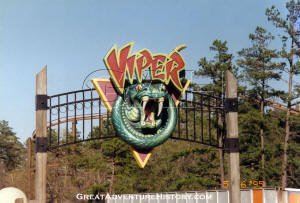|
Originally, Viper was to have been named "Unforgiven" and themed to the
Oscar winning Warner Brothers film starring Clint Eastwood. Market
research showed that the Unforgiven theme was too dark, and the name
Viper was chosen instead.
Throughout the Six
Flags chain the name Viper was used for a variety of coasters of all
shapes, sizes and types. The
same Viper logo was used repeatedly for all the coasters in the chain, with the
three dimensional snake’s head with triangular background found on signs
and in some cases actually on the coasters.
With the purchase of Six Flags by Time Warner in
1992, efforts were made throughout the park to bring themed elements to
areas that had no discernible look to them.
The vacant Ultra Twister area was a prime example, with sterile
concrete and very generic fences and fixtures.
The Best of the West and the Hernando’s Hideaway sections
which been separate theme areas were combined into the Frontier
Adventures section. The
vacant coaster site was the perfect spot for the addition of a western
themed ride, and the presentation of the ride was as important to the
park management as the ride itself.
Prep work began at the end of the 1994 season, clearing the
remnants of the Ultra Twister.
The Viper coaster itself was a prototype which had
been built by Togo at their headquarters in Ohio as a demonstration
of the company’s new innovations.
The ride introduced a new element called a “dive loop”, which
added an inline twist at the top of a vertical loop.
This was combined with the true heartline roll element found on the
Ultra Twister style coasters, but in a full circuit design with full
sized trains, improving on the capacity of the shuttle style Ultra
Twister design.
The prototype featured the spiral heartline roll
track encircled with steel rings, giving the ride a snake like
appearance. The small footprint of the coaster made it a good fit for
just about any park. When the Six Flags executives saw the ride, they
decided to purchase it, but to enhance the snake theme additional rings
were added to the lift hill and drop.
A snake like coaster was a good fit for a western themed section
of a park, and the empty Ultra Twister site was the right size to fit
the compact structure.


The
construction of Viper was delayed in the off-season and wasn’t completed
until June of 1995. Construction of the coaster structure continued
through April and May, and the construction of the elaborate station building and queue line
theme elements running right up to the opening of the ride in early June.
The emphasis on theme was clear with the meticulous attention to
the southwestern style details.
It served as the perfect transition between the Western themed
side of Frontier Adventures and the Spanish style side.




One small structure which had been part of the
Ultra Twister’s infrastructure was left in place near the ride entrance,
and the steel building was clad in rustic wood siding to fit the theme.
The queue was designed to follow along the sidewalks of a ghost
town. The ghost town
buildings were elaborate set pieces with no real structure behind them.
The area between the queue and the sidewalk became a southwestern
desert, complete with cacti (both real and faux) and aged western props
of all kinds.
The real focal point of Viper’s theme elements was
the station building and matching train shed, which were designed to
look like a crumbling Spanish Mission, with buttressed walls arched
windows and a bell tower complete with a huge bell.
The brand new building was aged to look like it was hundreds of
years old along with the weathered ghost town in front of it.
While the building looked old, it actually featured state of the
art technology with a special elevator adjacent to the entrance stairs,
making the ride handicapped accessible. The placement of the elevator
meant guests with disabilities could then wait on the regular queue
line.
 Viper was a ride with several unique elements, but
one that was often overlooked was the station configuration.
The station had two blocks, creating separate load and unload
positions which meant guests got on and off the train on the same side.
This often caused confusion with disembarking guests stepping out
of the wrong side of the train.
In theory the configuration could increase capacity with one
train loading while another cycled and then unloaded. However, with the
confusion of guests trying to find their stowed articles when their
train arrived in a different position than it had left, it often slowed
things down.


Another challenge to
the crew of Viper was the ride’s unique restraint system that was unlike
anything most guests had seen before.
The restraint was a two part system, with a lap bar and
independent shoulder harness which had to be lowered.
Often the train would have to be locked and unlocked several
times when guests would either set their shoulder harness too high or
too low.
|




